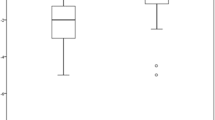Abstract
Purpose
To evaluate rotational stability and visual and refractive outcomes of supplementary toric IOLs (Sulcoflex Toric 653T, Rayner Intraocular Lenses Ltd) for residual astigmatic refractive error in pseudophakic eyes.
Methods
A retrospective interventional case series was conducted in a single surgeon practice. Charts of patients who had Sulcoflex Toric supplementary IOLs inserted between June 2009 and September 2015 were reviewed. Outcomes were compared between eyes with and without prior corneal transplant. Patients with at least 3-months follow-up were included.
Results
In 51 eyes, mean UDVA improved from 20/86 to 20/43 (p = 0.002), though UDVA was better in eyes without corneal grafts (20/31) than eyes with (20/62). The proportion of eyes achieving 20/20 UDVA was 43%, 61% and 17% overall, in eyes with prior graft and in eyes with no prior graft, respectively. Sixty-four percentage achieved a spherical equivalent of within 0.5D of target (84% no graft, 34% prior graft). Fifty-three percentage of eyes achieved a cylinder of within 0.5D of target (no graft: 73%, prior graft: 0%). Mean lens rotation was 8.23° on day 1, and mean maximal rotation during follow-up was 17.63°. Sixty-two percentage of IOLs required repositioning. Of those that required repositioning, this was conducted a mean of 2.3 times. The mean final IOL rotation (following repositioning if required) was 6.17°.
Conclusion
Sulcoflex Toric supplementary IOLs result in good visual and refractive outcomes in eyes with no prior corneal graft. However, outcomes are sub-optimal in eyes with prior corneal transplantation, and the majority of lenses require repositioning.









Similar content being viewed by others
References
Lehmann RP, Houtman DM (2012) Visual performance in cataract patients with low levels of postoperative astigmatism: full correction versus spherical equivalent correction. Clin Ophthalmol 6:333–338. https://doi.org/10.2147/OPTH.S28241
Wilkins MR, Allan B, Rubin G, Moorfields IOLSG (2009) Spectacle use after routine cataract surgery. Br J Ophthalmol 93(10):1307–1312. https://doi.org/10.1136/bjo.2008.151829
Kessel L, Andresen J, Tendal B, Erngaard D, Flesner P, Hjortdal J (2016) Toric intraocular lenses in the correction of astigmatism during cataract surgery: a systematic review and meta-analysis. Ophthalmology 123(2):275–286. https://doi.org/10.1016/j.ophtha.2015.10.002
Brick DC (1999) Risk management lessons from a review of 168 cataract surgery claims. Surv Ophthalmol 43(4):356–360
Jin GJ, Merkley KH, Crandall AS, Jones YJ (2008) Laser in situ keratomileusis versus lens-based surgery for correcting residual refractive error after cataract surgery. J Cataract Refract Surg 34(4):562–569. https://doi.org/10.1016/j.jcrs.2007.11.040
Kojima T, Horai R, Hara S, Nakamura H, Nakamura T, Satoh Y, Ichikawa K (2010) Correction of residual refractive error in pseudophakic eyes with the use of a secondary piggyback toric Implantable Collamer Lens. J Refract Surg 26(10):766–769. https://doi.org/10.3928/1081597X-20100512-02
Kim P, Briganti EM, Sutton GL, Lawless MA, Rogers CM, Hodge C (2005) Laser in situ keratomileusis for refractive error after cataract surgery. J Cataract Refract Surg 31(5):979–986. https://doi.org/10.1016/j.jcrs.2004.08.054
Kuo IC, O’Brien TP, Broman AT, Ghajarnia M, Jabbur NS (2005) Excimer laser surgery for correction of ametropia after cataract surgery. J Cataract Refract Surg 31(11):2104–2110. https://doi.org/10.1016/j.jcrs.2005.08.023
Hirnschall N, Gangwani V, Crnej A, Koshy J, Maurino V, Findl O (2014) Correction of moderate corneal astigmatism during cataract surgery: toric intraocular lens versus peripheral corneal relaxing incisions. J Cataract Refract Surg 40(3):354–361. https://doi.org/10.1016/j.jcrs.2013.08.049
Gills JP, Van der Karr MA (2002) Correcting high astigmatism with piggyback toric intraocular lens implantation. J Cataract Refract Surg 28(3):547–549
Falzon K, Stewart OG (2012) Correction of undesirable pseudophakic refractive error with the Sulcoflex intraocular lens. J Refract Surg 28(9):614–619. https://doi.org/10.3928/1081597X-20120809-01
Felipe A, Artigas JM, Diez-Ajenjo A, Garcia-Domene C, Alcocer P (2011) Residual astigmatism produced by toric intraocular lens rotation. J Cataract Refract Surg 37(10):1895–1901. https://doi.org/10.1016/j.jcrs.2011.04.036
Garzon N, Poyales F, de Zarate BO, Ruiz-Garcia JL, Quiroga JA (2015) Evaluation of rotation and visual outcomes after implantation of monofocal and multifocal toric intraocular lenses. J Refract Surg 31(2):90–97. https://doi.org/10.3928/1081597X-20150122-03
Iwase T, Tanaka N (2005) Elevated intraocular pressure in secondary piggyback intraocular lens implantation. J Cataract Refract Surg 31(9):1821–1823. https://doi.org/10.1016/j.jcrs.2005.06.034
Chang DF, Masket S, Miller KM, Braga-Mele R, Little BC, Mamalis N, Oetting TA, Packer M, Committee ACC (2009) Complications of sulcus placement of single-piece acrylic intraocular lenses: recommendations for backup IOL implantation following posterior capsule rupture. J Cataract Refract Surg 35(8):1445–1458. https://doi.org/10.1016/j.jcrs.2009.04.027
Gayton JL, Apple DJ, Peng Q, Visessook N, Sanders V, Werner L, Pandey SK, Escobar-Gomez M, Hoddinott DS, Van Der Karr M (2000) Interlenticular opacification: clinicopathological correlation of a complication of posterior chamber piggyback intraocular lenses. J Cataract Refract Surg 26(3):330–336
Ferreira TB, Pinheiro J (2015) Clinical results with a supplementary toric intraocular lens for the correction of astigmatism in pseudophakic patients. Eur J Ophthalmol 25(4):302–308. https://doi.org/10.5301/ejo.5000564
Khan MI, Muhtaseb M (2011) Performance of the Sulcoflex piggyback intraocular lens in pseudophakic patients. J Refract Surg 27(9):693–696. https://doi.org/10.3928/1081597X-20110512-01
Author information
Authors and Affiliations
Corresponding author
Ethics declarations
Conflict of interest
All authors declare no conflict of interest.
Ethical standard
All procedures performed were in accordance with the ethical standards of the involved institutions and with the 1964 Declaration of Helsinki and its later amendments. Ethics approval was obtained from the Metro South Human Research Ethics Committee (Brisbane, Australia). Informed consent was obtained from all individual participants included in the study.
Rights and permissions
About this article
Cite this article
McLintock, C.A., McKelvie, J., Gatzioufas, Z. et al. Outcomes of toric supplementary intraocular lenses for residual astigmatic refractive error in pseudophakic eyes. Int Ophthalmol 39, 1965–1972 (2019). https://doi.org/10.1007/s10792-018-1027-7
Received:
Accepted:
Published:
Issue Date:
DOI: https://doi.org/10.1007/s10792-018-1027-7




